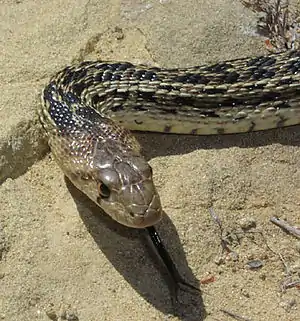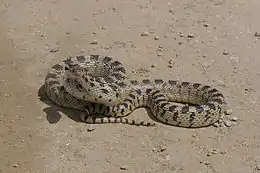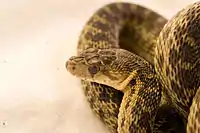Pituophis catenifer
Pituophis catenifer is a species of nonvenomous colubrid snake endemic to North America. Nine subspecies are currently recognized, including the nominotypical subspecies, Pituophis catenifer catenifer, described here.[5] This snake is often mistaken for the prairie rattlesnake, but can be easily distinguished from a rattlesnake by the lack of black and white banding on its tail and by the shape of its head, which is narrower than a rattlesnake's.
| Pituophis catenifer | |
|---|---|
 | |
| Scientific classification | |
| Kingdom: | Animalia |
| Phylum: | Chordata |
| Class: | Reptilia |
| Order: | Squamata |
| Suborder: | Serpentes |
| Family: | Colubridae |
| Genus: | Pituophis |
| Species: | P. catenifer |
| Binomial name | |
| Pituophis catenifer (Blainville, 1835) | |
| Synonyms | |
Etymology
The specific name, catenifer, is Latin for "chain-bearing", referring to the dorsal color pattern.
Description
Adults are 36-84 in (91–213 cm) in length.[4] Dorsally, they are yellowish or pale brown, with a series of large, dark brown or black blotches, and smaller, dark spots on the sides. Ventrally, they are yellowish, either uniform or with brown markings.[1]

Behavior
The gopher snake has an odd defensive mechanism, in which it puffs up its body and curls itself into the classic strike pose of a pit viper. However, rather than delivering an open-mouthed strike, the gopher snake is known for striking with a closed mouth, using its blunt nose to "warn off" possible predators. Also, it often shakes its tail, confusing predators into thinking it is a rattlesnake. This works best when the snake is in dry leaves or on gravel. It usually hunts its prey on land, but occasionally ventures out into ponds to hunt frogs.
Life expectancy

Wild gopher snakes typically live 12 to 15 years, but the oldest captive recorded lived over 33 years.[6]
Common names
Common names for this species, or its several subspecies, are: Pacific gopher snake, Henry snake, coast gopher snake, bullsnake, Churchill's bullsnake, Oregon bullsnake, Pacific pine snake, western bullsnake, western gopher snake, Sonoran gopher snake, western pine snake, great basin gopher snake, blow snake, and yellow gopher snake.[4]
Subspecies
| Subspecies[5] | Taxon author[5] | Common name | Geographic range |
|---|---|---|---|
| P. c. affinis | Hallowell, 1852 | Sonoran gopher snake | |
| P. c. annectens | Baird & Girard, 1853 | San Diego gopher snake | |
| P. c. bimaris | Klauber, 1946 | Central Baja California gopher snake | |
| P. c. catenifer | Blainville, 1835 | Pacific gopher snake | The United States, from Oregon west of the Cascade Range, south into California, west of the Sierra Nevada to northern Santa Barbara County and the Tehachapi Mountains.[4] |
| P. c. coronalis | Klauber, 1946 | Coronado Island gopher snake | Coronado, California |
| P. c. deserticola | Stejneger, 1893 | Great Basin gopher snake | |
| P. c. fulginatus | Klauber, 1946 | San Martin Island gopher snake | San Martin Island, Baja California |
| P. c. pumilis | Klauber, 1946 | Santa Cruz gopher snake | |
| P. c. sayi | Schlegel, 1837 | Bullsnake | Central and western North America. |
References
- Boulenger GA. 1894. Catalogue of the Snakes in the British Museum (Natural History). Volume II., Containing the Conclusion of the Colubridæ Aglyphæ. Trustees of the British Museum (Natural History). (Taylor and Francis, Printers.) London. xi + 382 pp. + Plates I.- XX. ("Coluber catenifer", pp. 67-68.)
- Stejneger L, Barbour T. 1917. A Check List of North American Amphibians and Reptiles. Harvard University Press. Cambridge Massachusetts. 125 pp. (Pituophis catenifer, pp. 85-86.)
- The Reptile Database. www.reptile-database.org.
- Wright AH, Wright AA. 1957. Handbook of Snakes of the United States and Canada. 2 volumes. Comstock Publishing Associates. (7th printing, 1985). 1,105 pp. ISBN 0-8014-0463-0. (Pituophis catenifer, pp. 588-609, Figures 171.-175., Map 46.)
- "Pituophis catenifer". Integrated Taxonomic Information System. Retrieved 4 February 2009.
- Hiatt, S. "The Pituophis Page". Retrieved 7 December 2012.
Further reading
- Blainville, H.D. 1835. Description de quelques espèces de reptiles de la Californie précédée de l'analyse d'un système général d'herpétologie et d'amphibiologie. Nouvelles Annales du Muséum d'Histoire Naturelle 4: 233-296. (Coluber catenifer, pp. 290–291 + Plate XXVI., Figures 2, 2A, 2B.)
External links
![]() Data related to Pituophis catenifer at Wikispecies
Data related to Pituophis catenifer at Wikispecies
- Pituophis catenifer at the Reptarium.cz Reptile Database. Accessed 4 February 2009.
| Wikimedia Commons has media related to Pituophis catenifer. |

